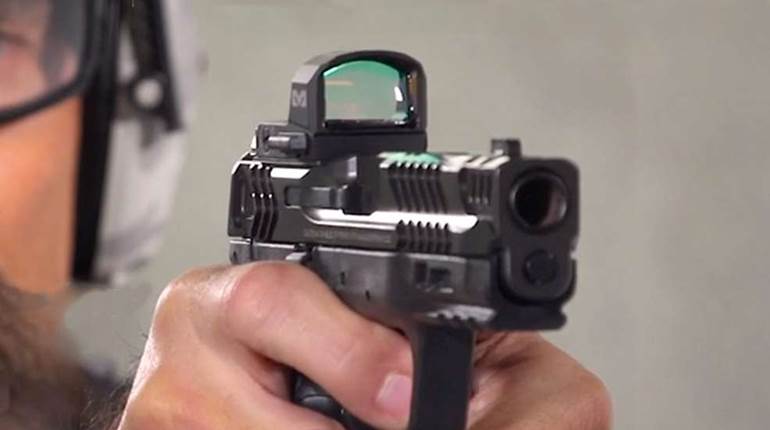
Bill Shadel, just returned after nearly two years in Europe as American Rifleman’s War Correspondent and CBS radio news reporter, submits herewith his personal … "Report to Riflemen." This article appeared in the July 1945 issue of American Rifleman. The earlier cover shown here is from Oct. 1943.
The lights of New York were laughing as we came into the harbor that night of May twenty-ninth. They were the beacons of welcome, the reception committee for some 9,000 heroes, hungry for the sight of them. Those lights, and the skyline of an undamaged city, and the glowing flare of a Coney Island—the gaiety, the amusement, the smiles and laughter those things represented—spelled in glowing letters to war-weary veterans the magic word: HOME!
Left far behind was a sullen, beaten, smouldering Germany. Here was laughter, the heart-warming, tingling smiles of fellowship. In Germany there are no smiles. This, was a breath of fresh air. Europe is depressing, still steeped in the foul air of misery and hate and vengeance.
My last ten days with the Navy aboard a Destroyer bring vividly to mind another trip on the high seas, a year ago. On the night of June fifth, aboard the Cruiser Tuscaloosa, when we started to move across the cold dark waters of the channel, the task of destroying the German Army looked tremendous. That Army included some 347 enemy divisions in all; sixty-odd of them in France, waiting behind the much-vaunted West Wall. A large proportion of the remainder was lined up against the Russians. The Russians were over a thousand miles to the east. There was little thought, in those days, of a junction between the two armies. The entire German Army was between us and our allies. Every thought was focused on those Normandy beaches and the hell of fire our men would soon be facing.
But those Normandy beaches were hit, and won. Reinforcements and supplies started building up. The fighting was bitter, in every village, at every crossroad and every hedgerow. The American as a fighting man was again on trial. How well he matched any performance seen previously in Europe is shown by the optimism which prevailed last fall, when V-E Day seemed so near.
I was assigned to cover General Patton’s Third Army. I was glad of that assignment, for, as everyone (including the Germans) knows, the brilliant campaigns of that Third Army made some of the greatest stories of the war. An Army assumes definite characteristics to the correspondent who is associated with it over a period of time. It takes on a personality all its own. And I developed an especial liking for the Third Army—because it represented so many things that seem to me to be typically American. It had color, dash, daring. It was bold and venturesome. It showed the world the things the world hoped for, yet dared not expect.
Then came the Battle of the Ardennes. Von Rundstedt had struck back in a desperate gamble. Momentarily, the American fighting man was forced into a defensive role, slugging it out with three powerful German Armies.
The magnificent 101st Airborne Division at Bastogne wrote history. So did the 1st, 2nd, and 99th divisions at Malmedy. So did the 82nd Airborne at Stavelot. All these and countless other places, individuals and divisions fought with quiet fury…and won. That victory added stature to the American fighting man.
This is the man we must not forget, this American fighting man—this civilian turned soldier—who kept war’s devastation away from our own shores.
We must not forget, either, the things he saw after the breakthrough; things we've tried to tell you and have failed to find words to describe: the horrors of the German concentration camps at Buchenwald, Dachau, Landsburg, Ebensee, and elsewhere. I saw the ones I’ve mentioned. I couldn’t describe them then; I can’t now. Things that haven't seen print; things that can't be printed. Believe me, none of the stories you've seen or heard, none of the pictures, have been exaggerated.
It is from such as this that the courage and tenacity of American fighting men saved us. For—notwithstanding our production lines, our machines, our engineering and productive skills—the American fighting man is America’s strength. He must always be strong, resourceful—and skilled. Skilled in the disciplines that, in a comparatively few months, can make a soldier. Skilled in the use of his weapons that can be thrown to his shoulder; thrown there naturally, with subconscious readiness and effectiveness. I have seen innumerable instances where this has paid off, has meant the difference between life and death, the difference between the success or failure of a patrol, the stand or rout of a company… And I have also seen the deplorable lack, among hurriedly trained replacements, of this all-important, morale-building ability.
Europe’s ills, and the repercussions, from those ills that so closely affect our own country, are by no means settled by the American fighting man's completion of his immediate job in Europe. We must at all times STAY prepared. For, in the Europe some of us have just left, power is the only thing that seems to count. If our own cities are to stand intact, if our factories and establishments are to be kept up to the potentials of conversion in an emergency, it will be only because we maintain a well-organized reserve of adequately trained fighting men and display to the world, and to any nation with notions of aggression, our readiness.
That’s why we need same form of universal military training. That’s why we need a National Rifle Association … to promote small-arms marksmanship, whether on the range or in the hunting field. I was never more convinced of the need of such skill; never more completely persuaded that it provides that essential something needed in addition to the American fighting man's heart and ability; a something which cannot be left to a few final, hurried months.
Space does not permit the recital here of untold instances where a hunter or a practiced target shooter, alone and single-handed, created havoc in the ranks of a determined enemy counterattack. I have tried to report some of those instances to you … The great tragedy is that there were not more of them. There could have been more, multiplied thousands more, if we had had more hunters, more expert riflemen, to call up from civilian ranks.
Next time, if there ever has to be a next time, it must be different! America must have those riflemen. American fighting men generally, not just in individual instances, must have that edge that skill with shoulder weapons gives.
I am convinced that we can and will have it; that the shooters of America, with evangelistic fervor, in the bonds of patriotism and good fellowship, will spread the gospel of shooting fun and shooting skill—for recreation and for national defense.





































